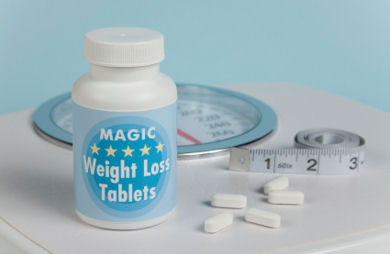|
Just as the first impressions of a person can influence our perception of them far into the future, research shows the same can be said for the foods we eat. Once a food or restaurant is deemed "healthy", we tend to let our guard down and forget about the facts of what we are truly eating – a proverbial junk-food wolf in a nutritious sheep's clothing. This phenomenon for food has been dubbed the "health halo" effect. You may have experienced a similar situation in another aspect of life: relationships. One of your friends may have become so smitten with one feature of a potential suitor (they're attractive or fun to be around) that they completely disregarded the ten other red flags about them (i.e. they’re chronically late, don’t have a job, quick to yell at others) even though everyone else, including you, clearly saw the inconsistencies. Don’t let the same thing happen to you with the foods that you eat! Here are a couple "seductive" labeling tactics that could lure you into eating foods that may just end up becoming a bad date for you and your waistline: Low-Carb, Low-Fat or Trans-Fat Free These labels are dangerous, because they mask the real issue: calories. Just because a food is labeled as low-carb, low-fat or trans-fat free does not necessarily make it low-calorie. Excess calories are what ultimately lead to weight gain, regardless of whether they are from carbs, fat, trans-fat or protein. Why do most foods with "low-carb" and "low-fat" labels tend to have similar calories to their full-carb and fat versions? Taste. To make the foods tasty, companies may add in significant amounts of fat (for "low-carb" foods) or sugar (for "low-fat" foods) during the production process. It goes beyond replacing one nutrient with the other (carbs vs. fat), the quality of the food itself can suffer as well. Added fats and sugars are rarely beneficial to us compared to the natural fats and sugars of foods like avocados and apples, which usually come along with health-promoting fiber, water, vitamins and minerals. So if the low-fat, low-carb or trans-fat free snacks taste processed or "too good to be true", they probably are. Finally, research has shown that people tend to over-eat these seductively labeled foods because they think they're eating "healthier." You actually may have been better off (and more satisfied) by eating a smaller portion of a regular snack. That's how the French paradox has developed: you can eat rich foods and stay slender, as long as you eat them in moderation. Ultimately it's the total calories that matter. All-Natural and Organic All-natural is a "feel good" phrase. It sounds nice and looks great on paper (or packages). Unfortunately from a health or calorie perspective, it means absolutely nothing. There are very few regulations regarding the use of the term "natural", so pretty much any pastry made from flour, butter and sugar can be called natural. Even many sugar-laden cereals are deemed natural. An analogy I tell my clients about the natural label is: many illicit drugs are considered natural because they come from plants … would you consume them if they were suddenly labeled "all-natural"? Click here for more labeling tactics you may have been fooled by from Food Network. Have you had any recent health halo realizations about the foods you're eating? More from Food Network: |
More From SparkPeople
|














